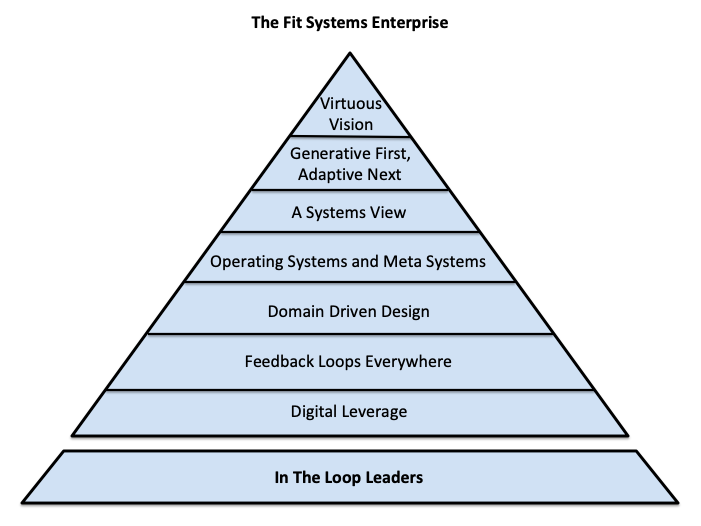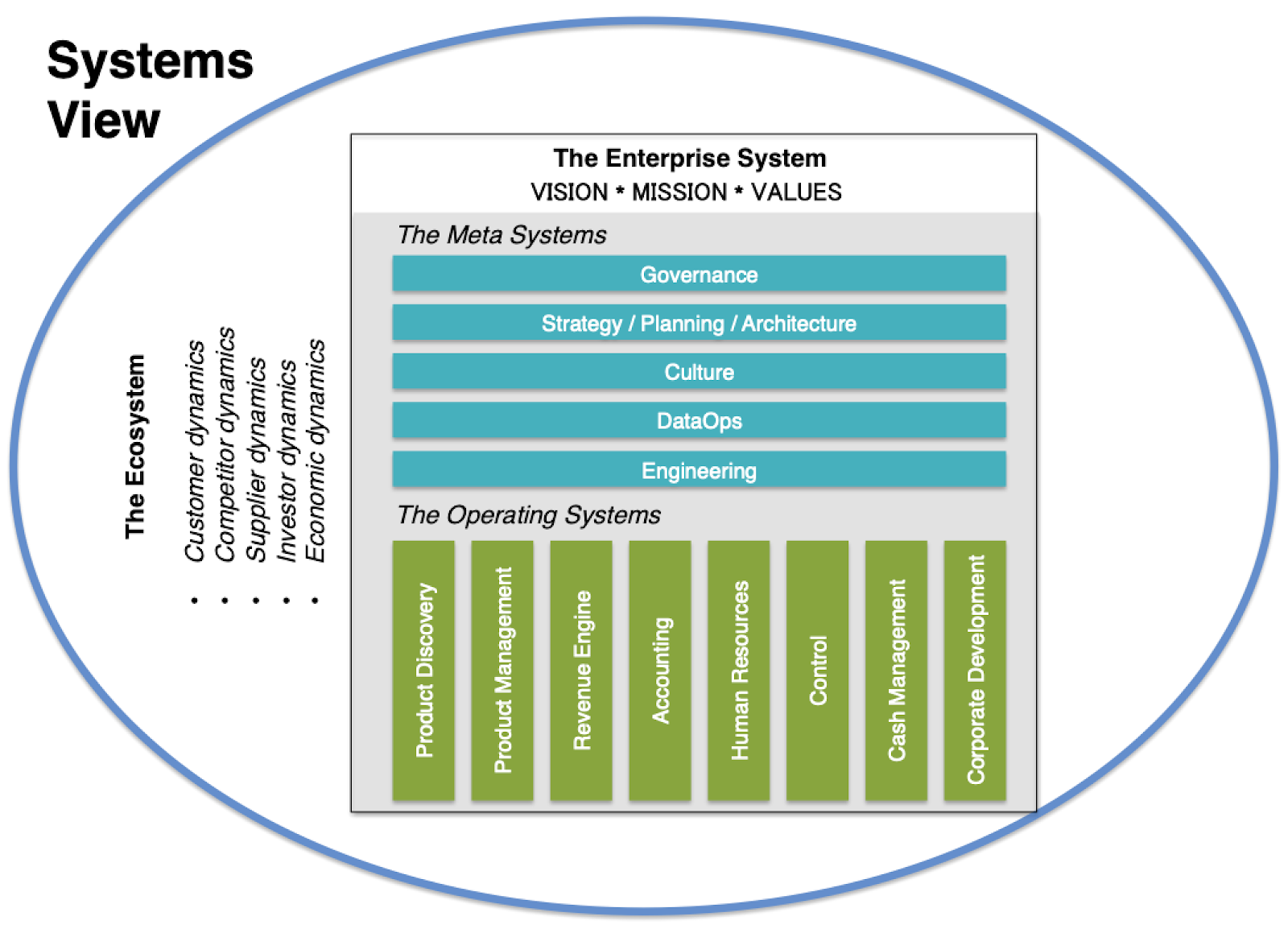Vision is the leader’s foresight: the end in mind as to what the enterprise will become. Its reach is limited only by the leader’s capacity to weave a thread between today’s reality and tomorrow’s possibility. A vision statement is the external expression of this inner vision. It paints a future picture of the company and its impact on customers, marketplace and community. When it emerges from a gifted leader’s hard-won and deeply felt vision, it can exert a powerful influence over company behavior.
Many companies have vision statements; few have great visions. In the fit systems enterprise, vision brings reality and possibility together. It is the starting point for strategy. It is the fulcrum of generative change. In the fit systems enterprise, it guides everything:

Google’s vision statement is “to provide instant access to the world’s information.” The vision of Microsoft is “to empower every person and every organization on the planet to achieve more.” Tesla’s is “to accelerate the world’s transition to sustainable energy.” Born of the insights of gifted leaders, these vision statements inspire and focus.
Where does vision come from?
Running a company can seem like a science project. To build a digital-at-the-center, fit systems enterprise, you sweat the interactions between people, workflows, technology and money flows. You assemble the right teams. You mobilize a strategy. You work on operating and meta systems — their stocks, flows and feedback loops. Inside every system and domain in the enterprise, you challenge teams to make improvements via the scientific method. They march down the narrowing path from hypothesis to truth in a continuous, data driven effort to improve. It’s all very scientific.
But the scientific method can’t give you a vision. Mechanistic means (first complete Step A, then B, then C) don’t get you there. Vision isn’t like that. It is art. Great art emerges intuitively, from the soul of the artist, to express some deep truth others couldn’t see. That’s how it is with vision. It requires the soul of a gifted leader; it is revealed as deep conviction in a core truth about those things the marketplace and world need that the company is foreordained to provide.
But where does it begin? It starts as concepts. It then becomes a set of words — a vision statement. These words convey to others the essence of the change the leader seeks to create in the world. This vision statement is important. If well crafted and honored, it will guide the enterprise for a long time. In a vision statement, the words used — the points of emphasis, as with a painting — are everything. Robert Pirsig, in his book Zen and the Art of Motorcycle Maintenance” said this:
“You want to paint a perfect painting? It’s easy. Make yourself perfect, and then just paint.”¹
He went on to say:
“Care and Quality are internal and external aspects of the same thing. A person who sees quality and feels it as he works is a person who cares. A person who cares about what he sees and does is a person who’s bound to have some characteristic of quality.”
The point is that a high quality vision cannot be separated from the leader or leaders who created it. It is an expression of who the leader is. You must care. You can’t pretend. If you care deeply enough about the ecosystem you occupy, the customers you serve and the company you lead — the problems your customers face, the aspirations of your investors, your employees’ search for connection and meaning and your impact on community and society — then you might, just might, be on your way towards a powerful vision.
For a vision to inspire, it must foresee positive change in the world. A great vision is steeped in virtue. Herb Kelleher was the founder and CEO of Southwest Airlines. He built it into the third largest airline in the world, serving 152 million passengers a year. He was a beloved leader, because he genuinely loved the employees of Southwest Airlines — and regularly said so. He spent time with frontline employees wherever he traveled, laughing with them, telling jokes and telling them how much he loved them. He was not afraid to use the word “love” with regularity. He wanted his employees to feel appreciated, to be happy, to have fun and to project that positive attitude to customers. That’s why “to be the most loved” is the first attribute highlighted in the company’s vision statement (“To be the most loved, flown and profitable airline in the world”). That’s why the company’s logo is a big heart. Love is the ever-beating heart of Southwest Airlines.
Don’t expect to discover your vision in a three-day retreat. No mechanistic exercise will yield a vision worthy of the name. A quality vision reveals itself to a dedicated leader grudgingly, after many observations and conversations, long walks on the beach and failed attempts.
There is a certain amount of suffering that must be endured on any road to excellence, and vision is no exception. Most vision statements fall short because the leader falls short. A high quality vision demands a lot of the CEO and the enterprise. Most leaders are afraid to create a vision statement that demands too much. Or they don’t take it seriously, and so fail to honor its words in their actions. That’s why so many vision statements are vacuous and ignored.
Steve Jobs conveyed the state of mind that animated his vision for Apple:
“When you’re a carpenter making a beautiful chest of drawers, you’re not going to use a piece of plywood on the back, even though it faces the wall and nobody will ever see it. You’ll know it’s there, so you’re going to use a beautiful piece of wood on the back. For you to sleep well at night, the aesthetic, the quality, has to be carried all the way through.” ²
Jobs’ commitment to quality was total. His commitment created a standard against which Apple continues to measure itself. Is it beautiful? Is it simple? Does it improve our customer’s life? Is it excellent in every way? Years after Steve Jobs departed Apple and the world, his vision lives on.
That’s the point. The right vision is enduring. There are just three times in the history of a company when it’s time to create or recreate your vision:
- At a company’s beginning
- Once you have confirmed product / market fit
- At a major pivot point — when a change in the core assumptions of your business is required
Prepare Yourself
As a digitally literate systems thinker, the In The Loop leader is uniquely qualified to birth a great vision. She cares deeply. She immerses herself in the ecosystem, the enterprise and the future.
When pondering the possible, the In The Loop leader takes into account emerging digital capabilities — blockchain, IoT, big data, machine learning, AI, mobile first, social, the cloud. She also considers emerging business models — SaaS, marketplace, ecommerce, ad-based and so forth. How do these affect what’s possible? She considers their potential to deliver customers and employees transformative benefits.
She also considers technology’s dark side — the privacy issues, the addictive risks, the security risks, the way user experience workflows can trick users into purchases. What can we become? What must we avoid?
Systems thinkers think holistically. They look beyond now; they consider near and far. They look beyond the enterprise; they consider the ecosystem and the world. They look beyond themselves; they consider the employee, the customer, the investor, the partner, the community.
A great vision is a virtuous vision. With today’s digital capabilities, it is all too easy to misuse technology. Your vision makes chosen virtues clear. For Google, it’s knowledge. For Apple, it’s beauty and simplicity. For Tesla, it’s sustainability. For Southwest Airlines, it’s love. How can your vision guide your company towards becoming a force for good in the world? It starts with you, the leader. Are you a force for good in the world? If you want to paint a perfect painting, become perfect and then paint.
The Vision Statement
In the fit systems enterprise, its vision statement’s words are spark plugs. They fire the engine of change. While it’s true a worthy vision emerges from the soul of a gifted leader, the vision statement is for everyone. Sweat the words. Make them memorable. The fewer the better. Mean them and lead by them, and they will motivate the behavior and guide the action of many.
Vision, Mission and Values
Vision is the end in mind. Mission is what you will do, for whom, and why — on the journey towards your vision. Your values define the behaviors you expect (from yourself and employees) along the way. These three work together. Collectively, they comprise the “north star” of the fit systems enterprise.
Evangelization
Your commitment to vision (and mission and values) is shown in the breach. Of course you will put up posters. Of course you will talk about the vision statement in your all hands meetings. You’ll include it in the employee handbook and employee on-boarding materials. But commitment is really shown when actions consistent with the vision are inconvenient, or hard, or risky.
One example of this is Google’s experience in China. Back in 2006, in order to gain access to the Chinese market, the company agreed to censor its search results. Within the company this was a controversial decision, because it seemed a direct affront to its vision (“the world’s information”) and values (“don’t be evil”). But Google didn’t completely cave. When Google.cn launched, searches for censored content resulted in a notice that appeared on screen, specifying that some results had been removed. It was Google’s tip of the hat to vision and values.
Chinese authorities hated the notice. Google knew posting it created the risk that regulators would shut Google.cn down. Though that didn’t happen right away, the Chinese government hit Google later, in the first days of 2010, with a massive hacking attack that exposed the email addresses of Chinese dissidents and other bad effects. For Google, that was the last straw. Later that same month, Google decided to exit the Chinese search market.
It was a costly decision. The Chinese government was now solidly anti-Google. As a result, Google’s position in China was compromised not just in search, but in everything. The door sprang open for Baidu to dominate Chinese search. Chinese technology companies (including Baidu, Alibaba, Tencent, Xaiomi, Meituan and Didi) stepped in and have since become dominant players in all aspects of Internet commerce. Google is on the sidelines.
Had Google been compliant from the outset, it would surely have assuaged regulators and established a leading and enduring position in the Chinese market. But it acted, perhaps imperfectly, on a vision and set of values that meant more than achieving success in the world’s largest market. Did it do enough to live out its vision and values? One could argue not. But the fact that these concepts animated internal debates and decisions is itself a nod to their power.
Leaders who are effective storytellers help bring vision to life. But vision becomes real when tough, painful and even costly decisions are made to advance it. Employees will take note. They will see leaders who do what they say, and say what they mean. Posters and speeches are important, but employees will be way more inspired and motivated by tough decisions and actions taken on behalf of a virtuous vision.
Vision and Strategic Choice

Vision guides strategic choice.
Over the years, Southwest Airlines’ vision to be the most loved airline in the world has guided a broad array of strategic decisions — in hiring, staffing, training and workplace culture. So too with Tesla’s commitment to sustainable energy. No company in the world has worked harder to perfect the car battery than Tesla. Many didn’t understand Tesla’s acquisition of SolarCity, but it’s perfectly consistent with the company’s vision.
At any given time, vision comes to life in an enterprise’s bounded purpose. A bounded purpose points the enterprise towards the next milestone on the scaling path. It unites what must be true with what can be true. A company’s “must be true” is the next value inflection point it must achieve, bounded in time. Its “can be true” reckons with capabilities and constraints. “Must be true” and “can be true” come together in bounded purpose. Strategy emerges from the bounded purpose; strategy is “how to make it true”.
Strategy is expressed first in terms of strategic imperatives: the two to five most critical outcomes required to achieve the bounded purpose. In every planning cycle, decisions are made to invest time, money and effort on these. They are hard evidence of the degree of commitment leaders have to the vision. If the vision is real, strategic imperatives will show it.
In Chapter 18 I will delve into the meta system I call the strategy, planning and architecture system. The chapter provides more detail about strategy creation, planning and their impact on enterprise architectures. The starting point of this meta system is vision. But of course, in the fit systems enterprise, vision is the starting point for everything.
Notes
- Pirsig, Robert M., 1974, Zen and the Art of Motorcycle Maintenance: An Inquiry Into Values. New York: William & Morrow Co.
- Isaacson, Walter, 2011. Steve Jobs. New York: Simon & Schuster.
To view all chapters go here.
If you would like more CEO insights into scaling your revenue engine and building a high-growth tech company, please visit us at CEOQuest.com, and follow us on LinkedIn, Twitter, and YouTube.

